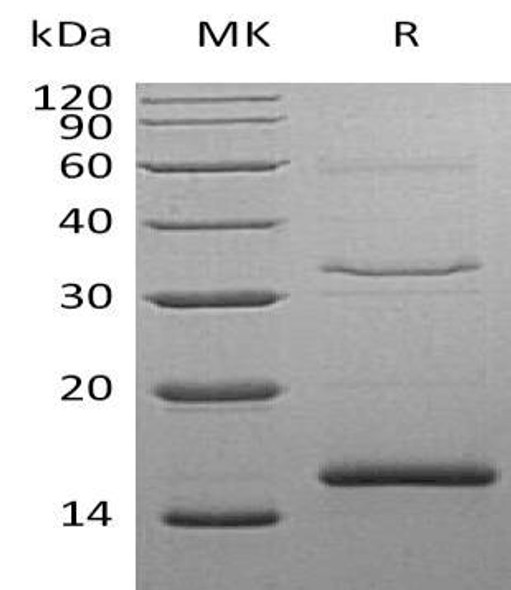Description
| Product Name: | Human CST4 Recombinant Protein |
| Product Code: | RPPB3290 |
| Size: | 10µg |
| Species: | Human |
| Target: | CST4 |
| Synonyms: | CystatinS, Salivary Acidic Protein 1, Cystatin-SA-III, Cystatin-4, Cystatin 4,Cystatin-S. |
| Source: | Sf9 Insect cells |
| Physical Appearance: | Sterile Filtered colorless solution. |
| Formulation: | CST4 protein solution (1mg/ml) contains PhosphateBuffered Saline (pH 7.4) and 10% glycerol. |
| Stability: | Store at 4°C if entire vial will be used within 2-4 weeks. Store, frozen at -20°C for longer periods of time.�For long term storage it is recommended to add a carrier protein (0.1% HSA or BSA).�Avoid multiple freeze-thaw cycles. |
| Purity: | Greaterthan 95.0% as determined by SDS-PAGE. |
| Amino Acid Sequence: | ADPMSSSKEE NRIIPGGIYD ADLNDEWVQR ALHFAISEYN KATEDEYYRR PLQVLRAREQ TFGGVNYFFD VEVGRTICTK SQPNLDTCAF HEQPELQKKQ LCSFEIYEVP WEDRMSLVNS RCQEAHHHHH H |
CST4 is a member of the cystatin superfamily which contains proteins that hold multiple cystatin-like sequences. Several family members are active cysteine protease inhibitors, whereas others have lost or possibly never attained this inhibitory activity. CST4 strongly inhibits papain (non-competitively) and ficin, partially inhibits stem bromelain and bovine cathepsin C, however does not inhibit porcine cathepsin B or clostripain.
CST4 produced in Sf9 Baculovirus cells is a single,glycosylated polypeptide chain containing 131 amino acids (21-141 a.a.) andhaving a molecular mass of 15.4kDa (Migrates at 13.5-18kDa on SDS-PAGE underreducing conditions).�CST4 is expressed with a 10 amino acid His tag atC-Terminus and purified by proprietary chromatographic techniques.
| UniProt Protein Function: | CST4: This protein strongly inhibits papain and ficin, partially inhibits stem bromelain and bovine cathepsin C, but does not inhibit porcine cathepsin B or clostripain. Papain is inhibited non-competitively. Belongs to the cystatin family. |
| UniProt Protein Details: | Protein type:Inhibitor; Secreted; Secreted, signal peptide Chromosomal Location of Human Ortholog: 20p11.21 Cellular Component: extracellular space Molecular Function:cysteine protease inhibitor activity; protease binding Biological Process: detection of chemical stimulus involved in sensory perception of bitter taste; negative regulation of proteolysis; retinal homeostasis |
| NCBI Summary: | The cystatin superfamily encompasses proteins that contain multiple cystatin-like sequences. Some of the members are active cysteine protease inhibitors, while others have lost or perhaps never acquired this inhibitory activity. There are three inhibitory families in the superfamily, including the type 1 cystatins (stefins), type 2 cystatins and the kininogens. The type 2 cystatin proteins are a class of cysteine proteinase inhibitors found in a variety of human fluids and secretions. The cystatin locus on chromosome 20 contains the majority of the type 2 cystatin genes and pseudogenes. This gene is located in the cystatin locus and encodes a type 2 salivary cysteine peptidase inhibitor. The protein is an S-type cystatin, based on its high level of expression in saliva, tears and seminal plasma. The specific role in these fluids is unclear but antibacterial and antiviral activity is present, consistent with a protective function. [provided by RefSeq, Jul 2008] |
| UniProt Code: | P01036 |
| NCBI GenInfo Identifier: | 4503109 |
| NCBI Gene ID: | 1472 |
| NCBI Accession: | |
| UniProt Secondary Accession: | P01036,Q9UBI5, Q9UCS9, |
| UniProt Related Accession: | P01036 |
| Molecular Weight: | 16,214 Da |
| NCBI Full Name: | cystatin-S |
| NCBI Synonym Full Names: | cystatin S |
| NCBI Official Symbol: | CST4�� |
| NCBI Protein Information: | cystatin-S |
| UniProt Protein Name: | Cystatin-S |
| UniProt Synonym Protein Names: | Cystatin-4; Cystatin-SA-III; Salivary acidic protein 1 |
| Protein Family: | Cystatin |
| UniProt Gene Name: | CST4�� |
| UniProt Entry Name: | CYTS_HUMAN |






